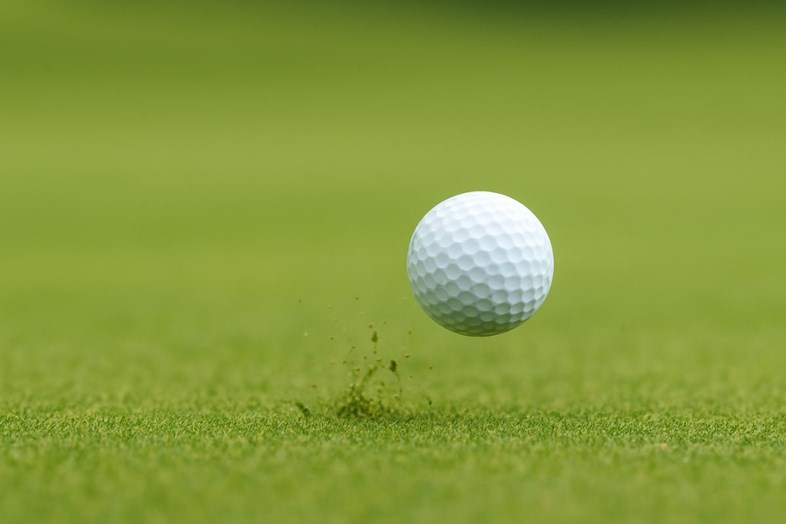It’s a distance model, but the best-performing cheap golf ball of the year is so much more than that. Allow us to explain…
Wouldn’t it be great if there were a cheap golf ball that could rival the best golf balls on the market? Well, there is…
We tested 62 golf balls in our 2025 robot test, and one model in particular stood out for its impressive performance and low price.
When some golfers hear ‘cheap,’ they immediately think the product will be inferior, but this golf ball outperformed Tour-approved premium golf balls, like the Titleist Pro V1 and Bridgestone Tour B X.
How we tested the golf balls
To find out, we tested 62 different golf balls on a $100,000 robot. This machine delivers the same strike every time, which means the only variable in our test was the ball itself.
We tested every ball across five different shot types to get a complete picture of how the balls stacked up:
114mph driver – PGA Tour average
93mph driver – LPGA Tour and typical male club golfer
78mph driver – average female club golfer
7-iron – 80mph, which is club golfer average
56° wedge – hitting a 40-yard pitch shot
The best cheap golf ball
Of the 62 golf balls we tested, the best cheap model is the Callaway Warbird Distance+.
This ball exceeded all of our expectations. Allow me to explain why…
Silver medal for tee to green performance at 93mph and 78mph and short game performance
I think it’s fair to say we were expecting the Callaway Warbird Distance+ to be a very middle-of-the-road two-piece golf ball. We definitely weren’t expecting this golf ball to perform as well as it has.
The Warbird Distance+ is Callaway’s cheapest golf ball, but it certainly doesn’t perform as though it is. This model scooped up the second-most awards in the two-piece category.
Tee to green performance is incredibly strong at all three swing speeds. The Warbird Distance+ won silver at 93mph and 78mph, and bronze at 114mph. Distance is definitely a strong factor, being the third-best golf ball off the tee in this category.
However, this golf ball isn’t purely a distance model (despite it being in its name). For short game performance, the Warbird Distance+ is the second-highest-spinning two-piece model (5,963rpm) and the third-highest-spinning Callaway golf ball.
We’re really impressed by the overall performance of the Warbird Distance+. It’s firmly put this golf ball on our radar, and with its test results, it should be for you, too!
On-course verdict
I didn’t have particularly high hopes for the Callaway Warbird Distance+ given its price, construction, and name, but I’m happy to have been proven wrong.
The Warbird Distance+ doesn’t feel the greatest. It’s slightly clicky and clunky, which doesn’t make the feedback and response very pleasant, but if you can look past that, this is a solid golf ball from tee to green.
Despite being a distance golf ball, the Warbird Distance+ offers much more than solely distance. This golf ball produces high-spin when attacking pins with an iron and wedge – something you don’t always expect from a distance golf ball, but it’s always appreciated.
Although the Warbird Distance+ offers more than distance, distance is very impressive with this model, thanks to the reduced spin. The carry distance is long, but the ball continues to roll a long way, delivering amazing total distance.
The Warbird Distance+ might not jump out as a must-have golf ball, but you won’t be disappointed if you give it a go – I most certainly wasn’t.
Pros & Cons Specs Features
Pros Solid tee to green performanceSurprisingly strong short-game performanceImpressive distance Carry distance (yds) Driver 114mph – 270.9 | Driver 93mph – 209.2 | Driver 78mph – 161.3 | 7-iron – 157.9 Ball speed (mph) Driver 114mph – 163 | Driver 93mph – 133.7 | Driver 78mph – 113 | 7-iron – 108.7 Backspin (rpm) Driver 114mph – 2,683 | Driver 93mph – 2,611 | Driver 78mph – 2,346 | 7-iron – 4,273 | Pitch – 5,963 Launch angle (°) Driver 114mph – 11.1 | Driver 93mph – 13 | Driver 78mph – 14.2 | 7-iron – 21.6 | Pitch – 30.7 Descent angle (°) Driver 114mph – 36.8 | Driver 93mph – 32.2 | Driver 78mph – 27.3 | 7-iron – 44.9 | Pitch – 36.1 Peak height (yds) Driver 114mph – 31.7 | Driver 93mph – 22.5 | Driver 78mph – 15.6 | 7-iron – 29.9 | Pitch – 6.9 Compression (psi) 92 Extra-large, high-energy coreHex aerodynamics332 dimples2-Piece constructionAvailable in white and yellow
There wasn’t one area in our test where the Warbird Distance+ underperformed. For a golf ball that costs just over a score, that’s hugely impressive.
Across the three driver swing speeds, iron shot, and pitch shot, the Warbird Distance+ finished in the top half of the rankings in every scoring area.
Hopefully, you’re coming around to the idea of trying the Warbird Distance+, but if not, take a look at the results compared to the No.1 ball in golf. After this, you’ll have to give the best cheap golf ball a try.
The results
We’ll break down the results into driver performance, irons, and wedges.
Driver – 78mph swing speedGolf ballCarry distance (yds)Carry distance rankBall speed (mph)Ball speed rankCallaway Warbird Distance+161.311th113.019thTitleist Pro V1161.016th113.114th
Both models perform admirably for golfers with slow swing speeds, ranking comfortably in the top half of our test for distance and ball speed. However, the Warbird Distance+ is longer despite the Pro V1 being faster – although there’s not much to split the pair in carry distance or ball speed.
Driver – 93mph swing speedGolf ballCarry distance (yds)Carry distance rankBall speed (mph)Ball speed rankCallaway Warbird Distance+209.212th133.719thTitleist Pro V1208.718th133.818th
It’s the same story for golfers with average swing speeds. If you’re looking for more distance, the Warbird Distance+ is the better option. The Pro V1 is once again faster, but that speed doesn’t translate into more distance, which isn’t ideal for a golf ball that’s more than double the price of the two-piece Callaway.
Driver – 114mph swing speedGolf ballCarry distance (yds)Carry distance rankBall speed (mph)Ball speed rankCallaway Warbird Distance+270.921st163.026thTitleist Pro V1273.27th163.910th
At 114mph is where we see the greatest difference in performance between the Warbird Distance+ and the No.1 ball in golf.
Golfers with quick swing speeds probably won’t be surprised to learn that the Pro V1 is both quicker and longer off the tee. However, is the extra couple of yards and mile an hour of ball speed worth the extra $30/£30?
Conclusion
The Wardbird Distance+ might not be longer and faster at every speed, but it is longer for slow swing speeds and average swing speeds, and it’s better than half the price of the Pro V1.
Distance and ball speed aren’t everything, and certain golfers will place more emphasis on spin and control, so how does the Warbird Distance+ compare against the Pro V1 with a scoring club in hand?
IronsGolf ballCarry distance (yds)Carry distance rankBackspin (rpm)Backspin rankDescent angle (°)Descent angle rankCallaway Warbird Distance+157.915th4,27347th44.930thTitleist Pro V1155.350th4,59826th44.929th
Distance is much less important with an iron in hand than it is with a driver, but over two yards extra carry from the Warbird Distance+ doesn’t go unnoticed.
For the extra distance over the Pro V1, it does hinder the amount of spin the two-piece Callaway model is able to produce, but just over 300rpm isn’t an awful lot, considering the difference in price.
It’s not as though the Pro V1 is ridiculously high-spinning, and the Warbird Distance+ isn’t going to hit and hold a green. So, despite being slightly lower-spinning, I don’t think it’s enough to make any golfer completely discount the Warbird Distance+.
Another important factor when approaching greens is descent angle. A steep descent angle is what helps a ball stop quickly on the green. The steeper the descent angle, the less the ball is going to leap forward on its first bounce. Although the Pro V1 is higher-spinning, the Warbird distance+ lands at the same descent angle.
Landing with the same descent angle means the Warbird Distance+ will roll out slightly more than the Pro V1 because it’s lower-spinning. But I imagine most golfers would be okay with seeing the ball carry slightly farther and roll out an extra yard, while saving over $30/£30.
Despite being lower-spinning, the Warbird Distance+ makes more appeal to me because it lands with the same descent angle, and producing over two yards more in carry distance is substantial. The Pro V1 does put up a good fight, but overall, I would rather have the performance of the Warbird Distance+ at my disposal – especially when you look at how it performs around the greens…
WedgesGolf ballBackspin (rpm)Backspin rankCallaway Warbird Distance+5,96315thTitleist Pro V15,69233rd
This will probably come as a major surprise to a lot of you. This was by far the biggest shock of the entire test when we first looked at all of the results.
The Warbird Distance+ was the 15th highest-spinning model – out of all 62 – from the 40-yard pitch shot. You might think 15th highest doesn’t sound particularly impressive. But, for a distance-oriented, two-piece, ionomer ball, it’s certainly punching its weight.
The two-piece Callaway produces nearly 300rpm more than the three-piece urethane Pro V1, and the No.1 ball in golf is in the bottom half for backspin rank in the 40-yard pitch.
I don’t imagine anyone will be throwing a challenge flag on this one – the Warbird Distance+ wins. The majority of golfers want more spin than less spin around the greens, and the Pro V1 generates less.
I did not think that was going to be a takeaway from our 2025 robot test!
Who should use the Callaway Warbird Distance+?
Based on our robot test findings, the Warbird Distance+ isn’t exclusive to anyone. It’s not as strong an option for golfers with fast swing speeds, but it’s not a bad option, by any stretch.
Who doesn’t want to play with a golf ball that performs well off the tee, gives you extra distance over the No.1 ball in golf, and spins more, too?
Oh, and it’s less than half the price!
The Warbird Distance+ isn’t all of a sudden going to be spotted on Tour, but for amateur golfers looking for an inexpensive golf ball that’s going to offer a ton of performance (overall more than the Pro V1), what reason do you have not to consider this golf ball?







